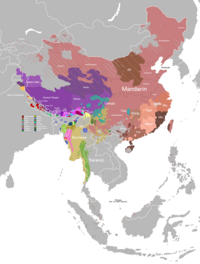Central Plains Mandarin
This article needs additional citations for verification. (November 2014) |
| Central Plains Mandarin | |
|---|---|
| 中原官话 Zhongyuan Guanhua | |
| Region | Yellow River Plain |
Native speakers | (170 million cited 1982)[1] |
| Chinese characters, Xiao'erjing (historical) | |
| Language codes | |
| ISO 639-3 | – |
| ISO 639-6 | zgyu |
cmn-zho | |
| Glottolog | huab1238 Central Plain Guanhuazhon1236 Zhongyuan |
| Linguasphere | 79-AAA-bf |
 | |
Central Plains Mandarin, or Zhongyuan Mandarin (simplified Chinese: 中原官话; traditional Chinese: 中原官話; pinyin: Zhōngyuán Guānhuà), is a variety of Mandarin Chinese spoken in the central and southern parts of Shaanxi, Henan, southwestern part of Shanxi, southern part of Gansu, far southern part of Hebei, northern Anhui, northern parts of Jiangsu, southern Xinjiang and southern Shandong.[2]
The archaic dialect in Peking opera is a form of Zhongyuan Mandarin.
Among Hui people, Zhongyuan Mandarin is sometimes written with the Arabic alphabet, called Xiao'erjing ("Children's script").
Subdialects
[edit]
- Zheng-Kai (郑开) region: e.g. Kaifeng (开封) dialect, Zhengzhou (郑州) dialect
- Luo-Song (洛嵩) region: e.g. Luoyang dialect (洛阳话)
- Nan-Lu (南阳) region: e.g. Nanyang (南阳) dialect
- Luo-Xiang (漯项) region: e.g. Zhumadian (驻马店) dialect
- Shang-Fu (商阜) region: e.g. Shangqiu (商丘) dialect, Fuyang (阜阳) dialect
- Xin-Beng (信蚌) region: e.g. Xinyang (信阳) dialect, Bengbu (蚌埠) dialect
- Yan-He (兖菏) region: e.g. Jining (济宁) dialect
- Xu-Huai (徐淮) region: e.g. Xuzhou dialect (徐州话)
- Fenhe (汾河) region: e.g. Linfen (临汾) dialect, Wanrong (万荣) dialect
- Guanzhong region (关中), e.g. Xi'an (西安) dialect
- Qin-Long (秦陇) region: e.g. Xining (西宁) dialect, Dunhuang (敦煌) dialect
- Longzhong (陇中) region: e.g. Tianshui (天水) dialect, Dingxi (定西) dialect[3]
- Hezhou (河州) Region: e.g. Gangou dialect (甘沟话) (influenced by Monguor)
- Nanjiang (南疆) Region: e.g. Yanqi dialect, Tulufan dialect
- Dungan language, written in Cyrillic, introduced many Russian loanwords, spoken mainly in Chu Valley and Fergana Valley in Central Asia
Phonology
[edit]In Central Plains Mandarin, some phonological changes have affected certain syllables but not Standard Chinese.
[p] and [pʰ] have shifted to [p͜f] before the vowel [u].[4]
| 布 | 跛 | 坡 | 朴 | |
|---|---|---|---|---|
| Middle Chinese Initial | [p] | [p] | [pʰ] | [pʰ] |
| Pinyin | bù | bǒ | pō | pǔ |
| Standard Mandarin | [pû] | [pwò] | [pʰwó] | [pʰù] |
| Central Plains Mandarin | [p͜fu] | [p͜fo] | [p͜fʰo] | [p͜fʰu] |
Standard Mandarin's [t͡ʂ], [t͡ʂʰ] and have shifted to [p͜f] before [u]. [ʂ] has shifted to [f] before [u].
| 猪 | 初 | 书 | 熟 | |
|---|---|---|---|---|
| Middle Chinese Initial | [ʈ] | [t͡ʃʰ] | [ɕ] | [ʑ] |
| Pinyin | zhū | chū | shū | shú |
| Standard Mandarin | [ʈʂú] | [ʈʂʰú] | [ʂú] | [ʂǔ] |
| Central Plains Mandarin | [p͜fu] | [p͜fu] | [fu] | [fu] |
See also
[edit]- Zhongyuan culture
- Central Plains (China), also called "Zhongyuan"
References
[edit]Citations
[edit]- ^ Gu 2009, p. 214.
- ^ Chappell 2002, p. 244; Gu 2009, p. 214; Chirkova 2008.
- ^ Wang, Menghuan; Ma, Shuzhen; Hu, Axu (2021). "Experimental Study on Citation Tone of Dingxi Dialect in Gansu Province". In Tavana, Madjid; Nedjah, Nadia; Alhajj, Reda (eds.). Emerging Trends in Intelligent and Interactive Systems and Applications. Advances in Intelligent Systems and Computing. Vol. 1304. Cham: Springer International Publishing. pp. 340–345. doi:10.1007/978-3-030-63784-2_43. ISBN 978-3-030-63784-2. S2CID 230557863.
- ^ Mian Yan, Margaret (2006). Introduction To Chinese Dialectology. Germany: LINCOM EUROPA. pp. 73–74.
Sources
[edit]- Chappell, Hilary (2002), "The Universal Syntax of Semantic Primes in Mandarin Chinese", in Goddard, Cliff; Wierzbicka, Anna (eds.), Meaning and Universal Grammar, Studies in Language Companion Series, vol. v. 60, Amsterdam; Philadelphia: John Benjamins, ISBN 1588112659, ISSN 0165-7763, OCLC 752499720, retrieved 17 November 2014
- Gu, Yueguo (2009) [2006], "Chinese", in Brown, Keith; Ogilvie, Sarah (eds.), Concise Encyclopedia of Languages of the World (1st ed.), Oxford, England: Elsevier, ISBN 9780080877747, OCLC 264358379, retrieved 17 November 2014
- Chirkova, Ekaterina (2008), "Gˇei 'give' in Beijing and beyond" (PDF), Cahiers de Linguistique Asie Orientale (37), Paris: Centre de recherches linguistiques sur l'Asie orientale: 3–42, ISSN 0153-3320, OCLC 793454655, retrieved 20 November 2014

